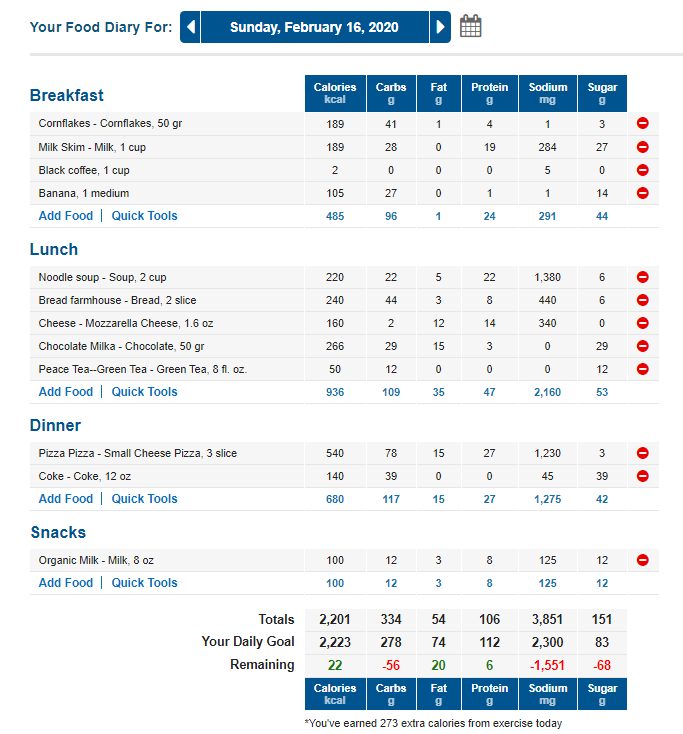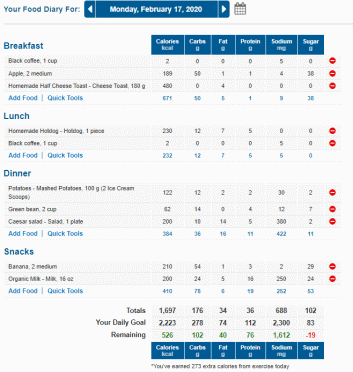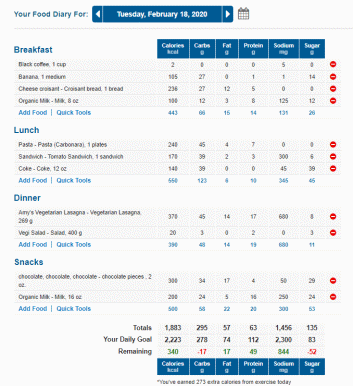Meal Pattern and Behavior
To analyze my meal pattern, I recorded data concerning my meals during the three days from Sunday, February 16 to Tuesday, February 18. During these days, I ate three meals every day, which is my typical meal pattern. I try to eat in moderate portions without any snacks. I try to avoid snacking, and in case I skip a meal, I prefer to wait for the next one instead of snacking. If I am hungry during the day, I eat fruits, which are usually bananas, oranges, or apples, and warm drink milk. In the evening, I also drink warm milk every day. I try to avoid all kinds of meat and fish because I think about becoming a vegetarian.
My eating habit during weekdays differs considerably from the weekends. During weekdays, I usually eat something that does not require a lot of time to cook. I also eat a lot less during weekdays and drink more water because I prefer to stay hungry rather than eat unhealthy foods. Unhealthy foods make me less productive. During weekends, I have more time to cook, so I may have something extraordinary for lunch from different ethnic cuisines. At the same time, I often go out with friends and may eat junk food, such as pizza or burgers. Therefore, during weekends I eat much more for dinner, and it is usually later than during weekdays.
My eating habits are significantly influenced by social and professional activity. I prefer to cook for myself; however, during weekdays, I do not have enough time to do that consistently. During weekends, I have time available during the day, so I try to diversify my diet. At the same time, I may eat more, because I can go to the restaurant or cinema with my friends.
Nutrient Targets Summary
During the three days of tracking my food, the intake of carbohydrates (CHO) was stable percentage-wise. It was 59% on Sunday, 62% on Monday, and 61% on Tuesday. Therefore, it may be stated that my average CHO intake is the target goal of 45%-65% of total calories as CHO. However, it should be noted that the amount of CHO differs considerably, being 334 grams on Sunday, 176 grams on Monday, and 295 grams on Tuesday.
The foods that contributed to CHO the most were pizza, whole-grain bread, lasagna, and sandwiches. I also drank some Coke on Sunday when I went out with my friends, which was mostly refined grain and sugar. During other days, I tried to limit myself to water and milk. My fiber intake differed considerably between days. It varied between 16.6 grams and 30 grams. However, in general, it may be said that my fiber intake is rather low. When I eat at home, I try to eat only whole-grain bread. I need to include oats and more green vegetables in my diet to increase my fiber intake.
I live a relatively active lifestyle. I walk my dog for 60 minutes every day and try to walk to places as much as I can. I also do hatha yoga for 10-20 minutes every day. My weight is around 50 kg. Considering this information, my daily protein intake should be the following:
I ate 106 grams of protein on Sunday, 36 grams on Monday, and 63 grams on Tuesday. Therefore, my average protein intake was the following:
My average intake of the nutrient is relatively high, and I need to control the consumption of protein-rich foods on weekends. My protein intake was around 15% of my overall caloric intake. I get the majority of my protein from animal-based foods, which are usually dairy products. To decrease protein intake, I need to consider drinking less milk and cheese. I also should replace some of the animal-based protein with plant-based protein, such as beans, peas, and tofu.
My recommended fat intake was 74 grams per day. The analysis of gathered information revealed that I need to increase fat-reach products, as my current score is considerably below the identified norm. At the same time, my saturated fat percent is above 50%. On average, I need to increase my fat intake by 35%, which is around 26 grams per day. The primary problem is that I do not have any healthy and stable sources of fat in my regular meals. I mostly get my fat from cheese and milk, which are the products I need to consume less due to my protein intake level. Therefore, I need to find sources of fats that do not increase my protein intake.
I do not eat any products to promote healthy fats intake. I should include more healthy sources of fat, such as extra-virgin olive oil, walnuts, chia seeds, and avocados.
According to the gathered data, I consume around 68 fluid ounces of liquid every day. My weight is 110 pounds, which implies that I need around 55 fluid ounces of liquid to stay hydrated. I believe that I drink just enough fluids as I eat very salty foods, which was not seen in the application. Moreover, I often drink coffee, which increases the amount of liquid I need. The majority of my fluids come from water, as I drink 4-6 glasses of water every day. However, I also often drink coffee and soda, which are not healthy fluids.
I scored very low on my vitamin D and E consumption, as well as the level of iron. To increase the intake of these vitamins, I should eat almonds, spinach, avocados, squash, kiwifruit, trout, shrimp, olive oil, and broccoli. However, I do not think that I need more vitamin D because I spend much time in the sunshine, which increases vitamin D. Usually, meat is rich in iron. However, since I try to avoid eating meat, I should consume more green leafy vegetables, whole grain, black and kidney beans, and lentils. At the same time, I need to cut my sodium consumption, which implies that I should eat less salt.
Food Groups and Calories
I believe that I tried to keep my diet relatively diverse, keeping an optimal amount of vegetables, dairy, fruits, and grains. However, according to choosemyplate.gov, I should pay more attention to protein foods. However, since I have decided to cut on meat, I need to find additional sources of healthy plant-based protein, which are soy products, beans, nuts, and seeds. At the same time, I believe that I consume too much milk and salt to address the issues concerning the current protein and sodium intake.
My daily calorie allowance was 2,223 calories per day, and I consistently scored lower than the needed amount by around 280 calories per day. Considering this data, my weight should decrease over time. However, I monitor my weight every day, and it has not gone up or down for the last year. Therefore, I believe that the disparities between the desired and actual calorie intake can be explained by inaccurate calculations or keeping the food diary.
Physical Activity
As mentioned above, I am relatively active since I try to walk instead of driving whenever I can. I also walk my dog twice a day for nearly half an hour. I start my mornings with 10-15 minutes of hatha yoga after a shower. Therefore, I believe that no alterations to my lifestyle should be made considering my calorie intake.
Supplements
I do not consume supplements.
Personal Reflection
In general, I am satisfied with the results of nutritional intake and physical activity analysis. I am conscious of what I eat and when I eat; therefore, there were no significant surprises. However, I found concerning the fact that I scored low on vitamin E. I do not have any symptoms of vitamin E deficiency, which are loss of feeling in the arms and legs, loss of body movement control, muscle weakness, and vision problems. The nutritional analysis revealed the possible problem, and I will investigate further on the matter.
Most of my eating habits promote a healthy lifestyle as I found that nutrient consumption pattern is vital for ensuring physical and emotional health. First, I keep a strict eating schedule: breakfast between 6 am, and 8 am, lunch between 11 am and 2 pm, and dinner between 4 pm and 6 pm. The exceptions to these rules happen rarely. Second, I do not eat snacks and let my digestive system rest between meals. Third, I keep a balanced diet that provides enough nutrients to sustain my current weight. Finally, I drink enough fluids to stay hydrated for the entire day. However, the fact that I eat too many salty foods and drink soft drinks and coffee arguably promotes an unhealthy lifestyle.
My central problem lies in the fact that I am in the process of transitioning from an omnivorous to a vegetarian diet. My diet has not stabilized since I need to find healthy and tasty substitutes for my favorite meat-based foods. Therefore, the present diet analysis was particularly helpful because it allowed me to identify two goals that will improve the current situation. First, I need to find healthy sources of fats, which can be reached by drinking 1-2 teaspoons of extra-virgin olive oil and including avocados in my diet. Second, I should reduce my sodium intake by reducing the amount of salt I put in my food. Even though I understand that I should also stay away from soft drinks and coffee, the goal would be unrealistic to achieve in the nearest future due to my emotional attachment and physical dependency on these products.
Conclusion
Diet and physical activity trackers, such as MyFitnessPal and Cronometer, are beneficial for people who are trying to lose weight or maintain a healthy lifestyle. Eating habits and physical activity analysis revealed that my overall performance is relatively balanced. I consume enough nutrients to support a moderately active lifestyle. However, there are minor modifications in my dietary habits I can make to avert future problems with physical and emotional health.
Reports
Sunday

Monday

Tuesday
